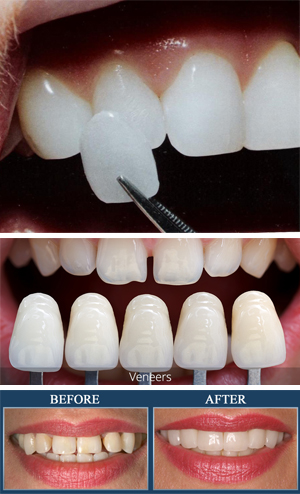Veneers

What is a Veneer?
It is a thin layer of porcelain made to fit over the front surface of a tooth, like a false fingernail fits over a nail.
What are the advantages of dental veneers?
Veneers can improve the colour, shape and position of your teeth.
The colour of a porcelain veneer can be selected such that it makes dark teeth appear whiter.
A veneer can make a chipped tooth look intact again.
Veneers can also be used to close gaps. If one tooth is slightly out of position, a veneer can sometimes be fitted to bring it into line with the others.
Porcelain veneers are stain resistant. Gum tissue tolerates porcelain well.
Very thin and are held in place by a special strong bond (rather like super-glue), thus very little tooth removal is needed.
How are teeth prepared for a veneer?
Local anaesthetic often is given making the procedure painless.
Stage 1: Some of the shiny outer enamel surface of the tooth may be removed. The amount of enamel
removed is tiny and will be the same as the thickness of the veneer to be fitted, so that the tooth stays the same size.
Stage 2: The dentist will take impressions (moulds) of the prepared tooth and of the opposing jaw.
Stage 3: Although it is not necessary to protect the tooth, for cosmetic reasons a temporary veneer can be made while you wait about a week for the permanent veneers to be made.
How is the veneer fitted?
Stage 4: Bonding a veneer in place is done with a special adhesive, which holds it firmly on the tooth.
Will the veneer match my other teeth?
Yes, the shade of the neighbouring teeth is picked from a range of shades by the patient (helped by the dentist and the nurse) to make sure the colour looks
natural and matches the surrounding teeth (or a whiter shade can be selected). We will try the veneer in for you to see before permanently cementing. We will get you to sign off that you are 100% happy for us to permanently cement it in (bring a friend if you like). Adjustments can be made to the veneer after it is fitted. It is usually best to wait a little while to get used to it before any changes are made.
How long will a veneer last?
Veneers should last for many years; but they can chip or break, just as your own teeth can. Small chips ca n be repaired, or a new veneer fitted if necessary. We will repair/replace a veneer free of charge in the unlikely event it fractures within 3 years of being made. Though not likely, veneers can dislodge and fall off. To minimize the chance of this occurring, do not bite your nails; chew on pencils, ice, or other hard objects; or otherwise put pressure on your teeth. You should also avoid sugary snacks, floss daily, and brush with a soft toothbrush. You must also agree to attend for six-monthly check-ups.
What are the other treatment options to porcelain veneers?
White Fillings: Covering part, or, all of the visible surface of the tooth. Unfortunately they don’t look as well, plaque and stains build up easily, and are not as strong.
Crowns: If a tooth is broken, weakened by decay, or has a large filling, a crown covering the whole tooth would be a stronger alternative. They can be made of porcelain so they can look just as good as a veneer.
Whitening: Usually very effective for discoloured teeth. Often, whole smile is whitened before placing veneers on a few front teeth. (only 150 euro,normally 500 euro)
Orthodontics to close gaps: Very good results, but typically takes 2 years and is expensive.
Do nothing. Up to 20% of the cost can be claimed back from the taxman. We will even complete the necessary forms for you!
